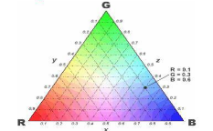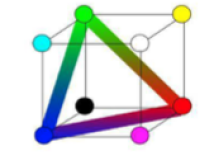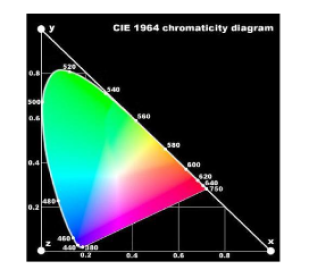Trichromy
The principle of trichromy lies in the discovery that a triplet of pure colors is sufficient to reproduce, through the mixing of these three components, which we can qualify as primaries, the entirety of colors. The Newton’s color circle can thus be ”summarized” into a triangle of primaries.

By filling the triangle of primaries according to the law of areas, we obtain the Maxwell triangle
Trichromy allows us to perceive all colors as a three-dimensional vector space, where three primary light sources (r, g, b) vary in intensity between 0 and 100. This principle of additive color synthesis is found in most color reproduction light devices: CRT, LCD, Plasma.
RGB Space
The RGB space is the vector space generated by the three primary components (Red, Green, Blue). The set of produced colors is represented as the interior of a cube, as illustrated in the following color triangle


XYZ Space
The XYZ space (CIE 1931) is defined through a linear transformation from the RGB space, ensuring that all colors in the visible spectrum are contained within the xyz triangle. The XYZ coordinates of natural colors always have positive values as a result of this transformation.

HSV Space
Human perception of color is a subjective reaction that can be characterized in terms of brightness, hue, and saturation.
Brightness corresponds to a sensation expressed with words like light, dark, bright, dim, etc.
Hue or chromatic tone corresponds to denominations like red, green, blue, etc. It represents the dominant wavelength of a color. White, black, or grays are considered neutral or achromatic.
Saturation is a measure estimating the colorfulness of a hue independently of brightness. It represents the purity of the perceived color as vivid or pale.
The conversion from RGB to HSV is achieved through a non-linear transforma- tion, and several operators have been proposed for this conversion.